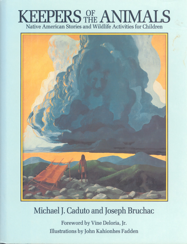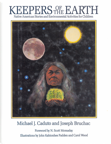Environmental Quality Resources
Air, Land, & Water Quality Vs. Pollution & climate change
I have a dream: That humanity will. learn to live sustainably within the limits of our finite world.
We need to keep both hopeful dreams and nightmare scenarios in mind if we are to build a world that can support life and is sustainable.
Overview
- Introduction
- General resources
- Change as too complicated or unknowable
- Cheaper Faster Better book review & notes
- Why Mars isn't a viable option
- Climate change comic: I'll be fine I brought an umbrella
- Conceptual model of the Earth systems
- Poison in a food chain
- Temperature of terrapin eggs determines male or female!
- Satellite pollution photo
- Fruit fly problem
Resources by
- Air - pollution related resources
- Land - pollution related resources
- Water - pollution related resources
- A lake's history - Great Lake or Peace Lake
Introduction
This page provides resources to support the study of pollution and climate change and related topics.
Focus questions:
- What is pollution and climate change?
- Pollution is the introduction of harmful or poisonous substances into the environment beyond the level that organisms in the ecosystem can use or tolerate. Information in this page are divided among the three main forms of pollutants: air, water, and land. Noise and light may included in some definitions.
- What is climate change? Climate change is the long-term shifts in temperatures and weather patterns, which can be caused by changes in the Sun or by large volcanic eruptions. Additionally, since the 1800s, a human increase in the burning of fossil fuels, has been a significant driver of climate change. The release of CO2, methane, and other other gases and particulate matter (PM) have impacted climate.
- How does pollution and climate change affect life on Earth?
- What can I learn about pollution and climate change to make healthy decisions for sustainable communities?
Resources
- Pollution unit - activities to explore air, water, & land pollution & how to reduce it.
- Information on sustainable communities
- Which goals and roles, developed for sustainable communities, relate to pollution and climate change?
- For a short history of a historical perspectives and thoughts on the environment, environmental education (EE), and sustainable development (SD) with educational topics, research, curriculum planning, and suggestions to integrate environmental issues into content areas, See - EE & SD.
- Life science units of study
- Eating the Earth pdf - pictures from big agricultural enterprises
General Resources
- Eco Justice Education. Routelege: NY. 2014. by Dana
- Smithsonian article explores the idea that Humans Have Exceeded Six of the Nine Boundaries Keeping Earth Habitable which suggest we are well outside the safe operating space for humanity according to a study that assesses the health of our planet.
- Sustainable futures field guide .PDF
- Braiding Sweetgrass: Indigenous Wisdom, Scientific Knowledge, and the Teachings of Plants. 2013. by Robin Wall Kimmerer.
- Psychological Roots of the Climate Crisis: Neoliberal exceptionalism and the culture of uncare. by Sally Weintrobe
- Environmental health teaching unit - includes: activity Lab notes (worksheets, word bank & key ideas). Content includes: Brainstorm prior knowledge of Nature, Create an environmental model with (environmental factors, organism in the environment, & environmental interactions to maintain a balanced sustainable ecosystem of nature, humans, needs for human survival and environmental variables), Environmental Health Disasters Activity, Historical decisions with Positive & Negative Environmental Impacts, Making healthy environmental decisions today, Influences on environmental decisions, Decision Making for personal and environmental health, Implementation of environmental decisions, and Review
- Ecosystems subject dimensions integration - Reviews a historical perspective of thoughts on the environment, reviews the state of environmental education (EE), a framework to use to integrate EE and sustainable development (SD) with educational topics, research to support EE and SD, scoring guide for environmental concerns, suggestions to assess environmental curriculum, ideas for planning EE & SD, suggestions to integrate environmental issues into content areas, and suggestions to plan ecosystem investigations. And finally a summary of the focus questions.
- Sustainable Communities! is a freely available community research guide developed by the Smithsonian Science Education Center (SSEC) in partnership with the InterAcademy Partnership as part of the Smithsonian Science for Global Goals project.
These Grade 3 - grade 8 research guides use the United Nations Sustainable Development Goals (SDGs) as a framework to focus on sustainable actions that are defined and implemented by students. - A People's Curriculum (k-12) for the Earth: Teaching Climate Change and the Environmental Crisis - A Zinn Education Project
- Sample activity - Cookie coal mining simulation
- Effect of Climate Warming on the Timing of Autumn Leaf Senescence Reverses after the Summer Solstice. M. Zohner et al. Science July 7, 2023.
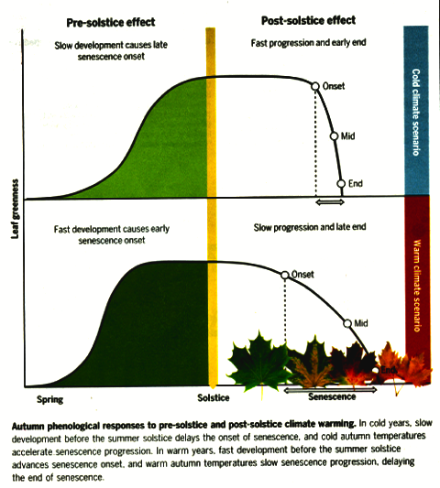
- Fact sheet for Civilization Failures and Environmental disasters
- The unsustainable harvest of coastal sands. Science December 8, 2023. Includes a good overview on the use of sand and possible sustainable management suggestions.
- Three books by Michael J. Caduto & Joseph Bruchac:. Each is an interdisciplinary program of study about Native American cultures and their ties to Animals, Nighttime activities, and Earth. The activities help explore the environment and engage each person's emotions, senses, thoughts, and actions to explore and expand their ideas of them self and their relationship to Earth, animals, humans, and sustainability. Activities include art, theater, reading, writing, science, social studies, math, and sensory awareness.
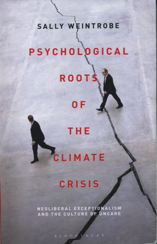
 Polar climate change
Polar climate change
Climate change in the polar regions of our warming world is threatening to transform many of its features, such as this icy tableau in the Fish Islands off the coast of the Antarctic Peninsula. There is still much to learn about these places before we know better what those changes may be. See the special section beginning on page 588. Includes six articles about polar ice and and the latest research on its past and present conditions and how we might predict possible futures.
Change, act, or what?
When people say something is too complicated or unknowable, it is usually an excuse to not do anything, which if applied to climate, is not survivable.
While the web of relationships within nature, among animals, people, weather, sun, soil, streams, fruit, livestock, is far too vast and complicated to fully comprehend.
We must accept the idea that some things were unknowable, and make the best choices we can with the information we have and be willing to be resilient for future changes when needed. To do otherwise and wait for perfect information, will result in our waiting forever. Or if you act as though you understand something completely, you'll make bad decisions.
Very good introductory lessons to develop understanding of waste, recycling, reuse, non=renuables, circular life cycle and circular business model (sustainable) Includes .pdf files, powerpoints, and worksheets.
Each grade level has three lessons that fit a learning cycle model across K-12 with five levels.
Primary K-2 Lessons include:
- Exploration - Learn to recycle primary grade lesson with story of rabbits learning to recycle
- Intermediate lesson Invent - Discover what can be recycled and how to recylce
- Discover or application extension lesson - Find it recycle it and learn how long different materials take to decompose
Level 2 Grades 3-5
- Beginner Lesson - Recyclable, Non-Recyclables, And Potential Recyclables review what can and can't be recycled and how.
- Intermediate Lesson - Where Does Your Recycling Go? to the ocean
- Advanced Lesson - What Can You Make From Recycling? Help the environment, save energy, conserve resources, use less, reuse, protects animals, make new products, includes many examples.
Level 3 - Grades 6-8
- Beginner Lesson - Waste Leakage In The Environment
- Intermediate Lesson - A Waste Hero's Story types for recycling
- Advanced Lesson - My Waste Audit - audit process with form
Level 4 - Grades 9-10
- Beginner Lesson - Linear vs Circular Life Cycle
- Intermediate Lesson - Creating The Circular Economy
- Advanced Lesson - Circular Design Challenge
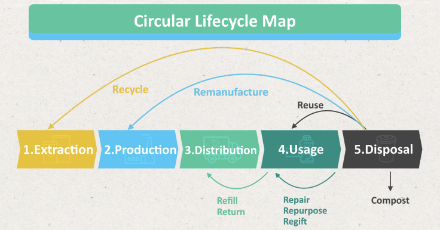
Level 5 - Grades 11-12
How to create a circular business model
- Beginner Lesson - Circular Case Study
- Intermediate Lesson - Redesign For Circularity
- Advanced Lesson - Circular Business Model Canvas
Optimistic book on climate
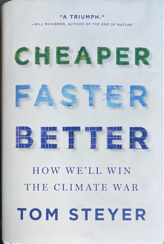 Cheaper Faster Better: How we'll win the climate war. by Tom Steyer. 2024.
Cheaper Faster Better: How we'll win the climate war. by Tom Steyer. 2024.
Tom explains his optimism for how the past should inform us to continue to make progress in keeping our planet inhabitable.
You might think: What are you talking about?
Climate is changing in ways to make it less habitable.
True, but Tom presents a convincing argument that positive change is happening!
When you read his book, will you agree with his conclusion!
I hope that by now you're a climate optimist, too.
We have a huge fight ahead of us, and the fossil fuel industry isn't going to fade away quietly.
But the tide has already turned.
Thanks to new technology, increased public awareness, new laws and rules, and new ways of measuring and understanding the impact of greenhouse gas pollution on our planet, the clean energy revolution hasn't just begun, it's become unstoppable.
More Notes from Cheaper Faster Better: How we’ll win the climate war. by Tom Steyer, 2024.
Today, our world needs to change quickly and we need teams to make that happen. We need new technologies, new ways of creating energy, new ways to cut emissions of greenhouse gas. Then, we need to figure out how to deploy these new technologies worldwide, in countries with wildly different levels of infrastructure, prosperity, and political stability, all while facing relentless opposition from fossil fuels.
A summary of areas of concern with possible solutions is organized by: Energy provided as electrical for transportation, manufacturing, agriculture, and habital buildings.
1. Electricity generation. The great thing about all the power, if you ignore the fact that they're killing us, is that they're powerhouses of stored energy: For more than a century, we've turned that pent-up energy into heat and used that heat to create electricity. We need to create more electricity than ever as things that used to be powered by fossil fuels, like cars, are going to become electric; as the world population grows; and as more countries access the miracles of modern life. If we want to do this without destroying human society, as we know it, we need to create all that electricity in a way that doesn't rely on fossil fuel-generated heat. That means building up existing clean and renewable technologies like solar, wind, geothermal, and, if it can be done cleanly and safely, nuclear. It means trying to find new sources of energy and electricity, for example through nuclear fusion. It also means that we need to support all the things that get the electricity wherever it needs to go-better batteries, transmission lines, and power grids.
2. Transportation. Burning fossil fuels is one way to move vehicles from point A to point B. We need a better way. Electric cars, electric trucks, electric buses, and the charging networks needed to connect them to clean-energy grids will play a large role here. Making public transportation more efficient and reliable will help get cars and pollution associated with manufacturing them as well as driving them— Off the road as well. But other types of transportation are harder to electrify, especially passenger and cargo planes, because at the moment, any battery big enough to power them would be too heavy to get off the ground. Shipping whether by truck or boat is hard to electrify as well, for a similar reason: a big battery takes up space that could be occupied by cargo. That means we'll need to rely not just on new sources of electricity but on new battery technologies and new sources of fuel. (One possibility is green hydrogen. We need to move down the technology cost curve, but if we can make it work, it will be better, faster, cheaper, and cleaner than anything else out there).
3. Manufacturing. Let's say you buy an electric car and hook it up to a grid powered by renewable energy. That's zero greenhouse-gas pollution. But what about all the carbon and methane emitted when they were building that car? Or your phone? Or your clothing? Or basically anything else manufactured, which these days is almost everything? The basic problem is that manufacturing takes an enormous amount of energy, and in particular requires very high heat. We need to figure out how to make things using less heat, and how to generate heat without generating as many emissions.
4. Agriculture. As we feed a growing world wide population, the ways we raise plants and animals have to change. For example, nitrogen fertilizer-which didn't exist 120 years ago but today is considered essential to industrial farming— is a huge source of emissions because it's made using fossil fuels. There's also the problem of deforestation. When an acre of rain forest is cut down to clear land for a palm oil plantation or a cattle ranch, it's like wringing a giant sponge full of greenhouse gas into the air. We have to start producing the food we need without all the emissions.
See: The Burgeoning Global Food Trade is a Lifeline for Billions. Is it breaking the planet?
Science. Includes some rally astonishing photos. pdf
5. Buildings. Plumbing, Air conditioning, and Heating. Whether it's a house, an office, or any other type of modern structure, our buildings use an enormous amount of energy, and right now that means they create an enormous amount of greenhouse gas pollution. Even worse, most buildings leak. We need to make sure that what we're building today is net-zero emissions. But because it's estimated that in developed economies, about 80 percent of buildings in use today will still be in use in 2050, focusing on new construction alone isn't enough. We need to retrofit old buildings so that they waste less energy—and cost their owners less money in the process.
Over the years, as I made a lot of money, it didn't make me any smarter. It just meant I had more money.
Tom Steyer
If you want me in at the landing, ask me in on the takeoff.
George Shultz
Think about it!
How can the fossil fuel industry and supporters claim to be in favor of free markets, small government, and government hand outs; when they abandoned the principle of small government to attack clean energy by trying to shut down clean and green energies from the market with government regulations. And they themselves lobby for more tax breaks and handouts for expanding production and price supports to protect them from foreign markets.
Donald Trump can't claim to be "America First" while trying to keep cleaner, cheaper, safer energy out of Americans' hands. And you can't claim to be tough enough to stand up to countries like China while surrendering our competitive advantage in one of the world's fastest-growing industries. powerful conservative think tank abandoned the principle of small government to attack clean energy and support fossil fuel industries! Climate justice aligns with actions that are pro environment.
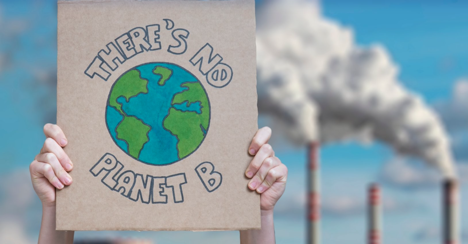
Why Mars isn't an option to save humanity
People who argue for space exploration as a solution should be reminded, Mars is a very inhospitable place. For example:
- Mars' temperature can regularly reach minus 81 degrees F.
- The planet's atmosphere is 95% carbon dioxide.
- Reduced gravity would require daily training to stay in shape.
- Its soil has perchlorates (chlorine compounds) that make it poisonous to life.
- It gets only 60% of the amount of light the Earth gets.
- The psychological effects of being isolated on a hostile planet.
- Travel to and from at its best is only every two years when Mar's orbit is closest to Earth.
- A communication with anyone on Earth would take between 4 and 20 minutes for the signal to travel from one planet to the other depending on their relative positions.
Climate change
Climate change comic: I'll be fine I brought an umbrella
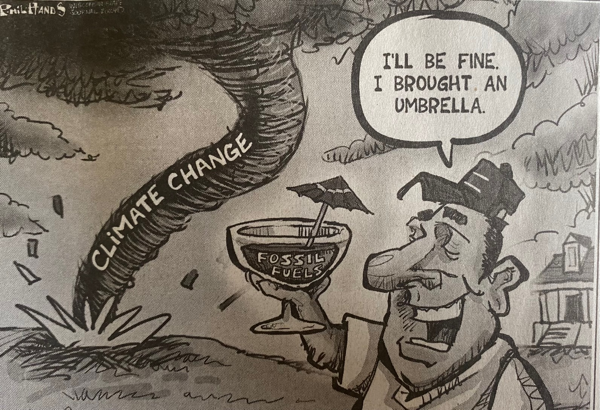
Poison in a food chain

Temperature of terrapin eggs determines male or female!

The sex of terrapins is determined by the temperature of the egg during its incubation. A warmer temperature creates females and cooler males.
Air
Book -
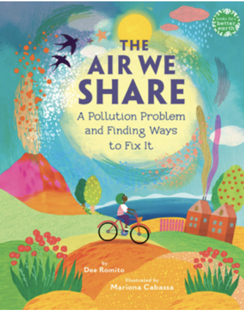
The air we share: Pollutioni problems and finding ways to fix it
by dee Romito. Ill. Mariona Cabassa
Grades K-4
Focus learners with the focus questions for this book.
Air pollution is a problem.
Read aloud and discuss:
- How did it happen?
- How do we fix it?
- Read aloud and engage discussion with:
- What do you think air pollution is?
- How does the air get polluted?
- Why do you think the author stated that it is air we share?
- Why do you think she would say that we share the air?
More pollution activities
Air pollution examples, outcomes, and personal safety

Particulate matter & health
Particulate matter - Model
Particulate matter (PM) is small pieces of solid or liquid or a combination of both kinds of matter small enough to travel in the air and therefore, can be inhaled by people. Particle size ranges from 0.005 micrometer to 1.0 micrometer (1 micrometer (µm) is one millionth of a meter).
They can be made of soil, soot, dust, pollen, metals, and much more. Scientists often group PM into different classes based on size. Three examples are shown below.

Particulate matter (PM) is the greatest health threat because it travels deep into the lungs and embeds in the lung tissue. Particles small enough to not only penetrate the lung alveoli, but penetrate blood vessels. Where they enter the bloodstream and can travel to other body systems and organs: such as the cardiovascular system, liver, and kidneys, and affect them.
Numerous studies have linked elevated particle levels in the air to increased hospital admissions, emergency room visits, asthma attacks and premature death for those with respiratory problems. Children are more susceptible than healthy adults because their lungs and respiratory systems are developing and may thus increases the frequency of childhood illnesses and reduced lung function.
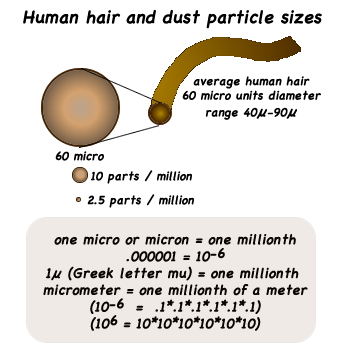
Making matters worse. When dust travels long distances, its particles change in size, shape, and chemically. This travel reduces their sizes and accumulates pollutants through chemical reactions that add harmful pollutants to the particles, all making them more toxic. This poses a danger to living organisms downwind and disrupts ecosystems.
Additional information: Here's how air pollution kills 3,450,000 people a year by Sara Chodosh and Kendra Pierre-Louis. Popular Science, March 30, 2017
Smog & human health
Smog is Particulate matter (PM)

Air pollution dust ... Particulate matter (PM)

When dust travels long distances, its particles change in size and shape and undergo chemical reactions that accumulate harmful pollutants. As they travel, their sizes decrease and pollutants accumulate, making them more toxic. This poses a danger to living organisms downwind and disrupts ecosystems.
Land
Ideas on plastic pollution
- We must have a treaty or global agreement to achieve a circular economy where plastic is reused and waste prevention through limiting production.
- Continued plastic use must be designed for longevity of the plastic materials along with building an infrastructure for reuse systems.
- Present subsidies to the fossil fuel industry need to be stopped.
- Someone needs to claim responsibility for plastic cleanup and building a new infrastructure.
- Those who use plastic need to accept the real cost of plastic use to society, health, and the environment to make it cost effective to make a switch.
- Recognize that reduced production is not a viable solution, but a smokescreen for change.
- Must reject any limiting of implementation of a solution which is not comprehensive.
- Must recognize the immediate urgency to prohibit particular plastic products polymers and other restricted plastics.
- Recognize that plastics have exceeded a safe operating space for human rights of a safe and clean environment.
- We must recognize that our current political systems are historically ill suited to address crises. As they are slow and cumbersome as lobbyist push for a laissez-fare unregulated economy and politicians are afraid to take bold actions that might upset the power brokers of wall street. So they cobble together timid solutions hoping to appear that they will solve the problems, but they will not.
Uranium mining in the Grand Canyon region ...

Water
The Saga of Great Lake or Big River
A large community of organisms lives beneath the surface of Great Lake. Light that penetrates the surface and minerals suspended in the water support plants, which are the basis of the lake's food web. All the plants and animals in the lake are part of this food web. Some of the organisms in the food web are algae, Daphnia, minnow, bass, trout, perch, frogs, snails, crayfish, clams, turtles, and beaver.
The first Europeans to find the lake were fur trappers, who reported that several Indian tribes lived near the shore. The Indians apparently had been there a long time because their villages and fields were well established. Like the Indians, European settlers were attracted to the lake. The land was fertile and moist, and crops grown there could provide food for many families. Moose and deer from the forest, fish from the lake, and ducks and geese added meat to the settler's diet. There was a great deal of fur trading because of the many mink, beaver, fox, and ermine living nearby. All in all, life was ideal.
As word about the lake's productivity spread, more and more people were attracted to the are. Soon the lakeside human population was too large to be supported by the existing fields. Forests were cleared to develop more and more farmland. As the forest diminished, the game that had been the settler's meat supply also disappeared. Cattle and sheep were raised to provide homegrown meat, and more forest were cleared to make grazing land for these animals.
Fur-bearing animals disappeared when the forests were cut down. The settlers originally traded furs for items such as cloth, firearms, plows, and luxuries they could not manufacture. They tried to solve this problem by producing some of the things formerly obtained through trade. Then the settlers expanded their workshops into small factories, producing items to take the place of furs in order to reestablish trade with other areas.
Many factories were successful, and people were attracted from other areas to work in them. As a result, population increased, additional food was required, and the remaining forests were converted into cropland. Slowly but surely, the lade area evolved into the massive industrial and agricultural center it is today.
Soon after lake shore industry was firmly established, there were no more forests that could be cleared for farming. In order to produce enough food to feed the rapidly growing population, the lakeside farmers stopped rotating crops and planted food crops on all available land. Within a few years they discovered they had made a mistake, because their yields decreased until finally farms could produce no crops at all.
About that time, commercial fertilizers were developed. By using fertilizers farmers could plant all their fields every year without worrying about using up the minerals in the soil.
When a large group of people lives in one area, there is a huge amount of waste material produced. Tons of garbage and sewage must be disposed of each day. The presence of the lake made this job easy, for it was simple matter to run sewage lines to the water's edge, dump garbage from piers, and let the city's waste float away. Before long, people stopped dumping garbage into the lake because much of it floated and was ugly. The sewage was not visible, however, so there seemed no harm in continuing to dispose of it in the lake.
A few years later, people noticed more algae in the lake than before. At first this increase was apparent only as occasional small clumps that had been washed ashore, or as a green film on offshore rocks. then swimmers complained about the slime that clung to their bodies when they came out of the water, and boaters described large, propeller-snagging masses of algae floating in the lake. Soon, the mayor's office was swamped with many angry descriptions of the foul odor encountered everywhere near the water. By this time no more people who fished lived near the lake. They had moved elsewhere in order to catch enough fish to support their families. A reporter for the local newspaper wrote that the crowds of Sunday afternoon swimmers and picnickers on the beaches had been replaced by dead fish and masses of rotting algae.
Now that you have read the story, answer the following questions.
- What do you think caused the increase in the lake's algae population?
- How is the disappearance of the fish related to the foul odor and the increase in algae?
- Why were the lake's problems evident only in recent years?
- If you could rewrite the story, what events would you change to keep the lake from becoming polluted?
Source - Maybe SCIS, however ... another book could also be used. Like.
A River Ran Wild by Lynne Cherry. 1992.
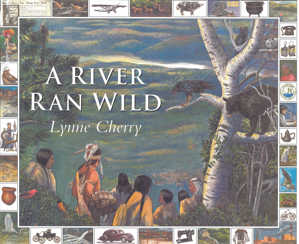 The book describes the history of the New England Nashua River and the affects it had on people and the affect people had on the river. From the river's first encounter with Native Americans up to present day.
The book describes the history of the New England Nashua River and the affects it had on people and the affect people had on the river. From the river's first encounter with Native Americans up to present day.
The story of the river and its relationship with humans is told both in text and beautiful illustrations of the life along the river and the technology of the people who live on its banks through time. As a bonus the borders are embedded with colored pencil drawings of the cultural artifacts of the people during the time being depicted.
A good story with enough detail and inspirational stirrings to hopefully motivate readers to deeper research into history of this river or other more personal histories of the reader. While the story has utility for historical research and historical understanding the book is more significant in its contribution for being a ground breaking children's story about water pollution.
Climate change examples

Rain storm

Satellite pollution

Fruit fly problem
Two fruit flies are put into a jar at midnight.
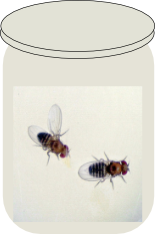 They and their descendants reproduce and double every minute.
They and their descendants reproduce and double every minute.
At noon the next day the jar is full.
When was the jar half full?
- When did the fruit flies know they were in trouble?
- If the Earth is the jar, and we are fruit flies, then, when will our jar be full?
- When will we know we are in trouble?
*answer*
The jar will be full:
One minute before noon or 11:59 AM.
I suppose the fruit flies could have solved their problem two ways. Not filling up the jar and by getting a bigger jar!
While the obvious analogy of relating the fruit fly's problem is to over population. It could apply to the recognition of other problems with a limited amount of time before the problem overwhelms any solution.
For example.
There is a colony of ants that work very hard to keep their colony happy and lively. As they do they produce ... pick one ... (CO2 or plastic), which they store in their colony.. Since they are so prosperous the amount of (CO2 or plastic) doubles every minute. If their colony is half full at noon, when will it be full?
Home: Pedagogy - theory, curriculum, learning, human development, & teaching
